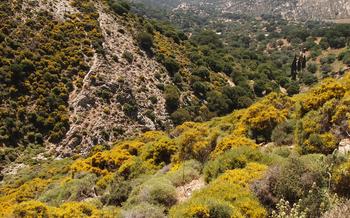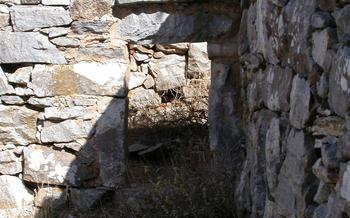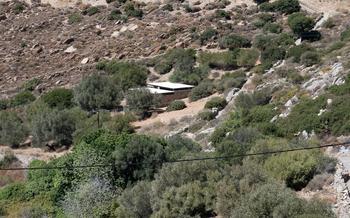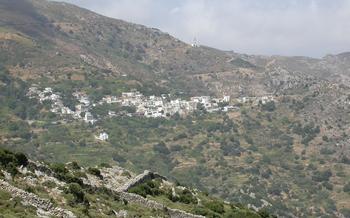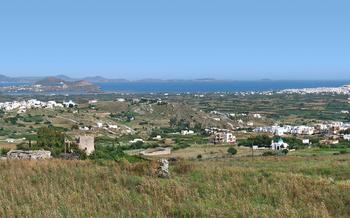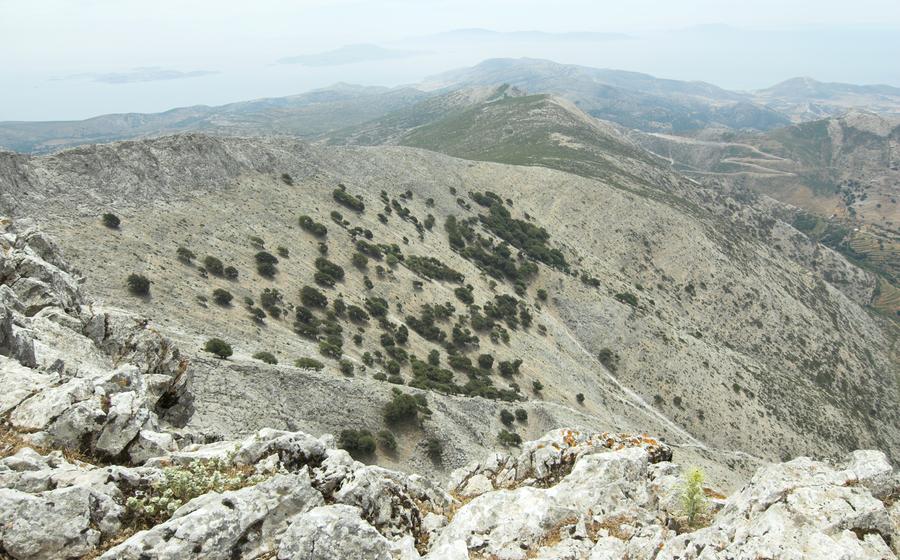
Mount Zas (Zeus)
- Mount Zas (Zeus): A Majestic Summit in Naxos
- Hiking to the Peak of Mount Zas
- The Temple of Zeus: A Sanctuary of Ancient Worship
- The Cave of Zeus: A Mythological Birthplace
- The Panagia Drossiani Monastery: A Byzantine Gem
- The Valley of the Muses: A Place of Inspiration
- The Venetian Castle of Naxos: A Symbol of Medieval Power
- The Archaeological Museum of Naxos: A Treasure Trove of History
- The Beaches of Naxos: A Coastal Paradise
- The Local Cuisine of Naxos: A Culinary Delight
- Getting to Naxos: A Traveler's Guide
Mount Zas (Zeus): A Majestic Summit in Naxos
In the heart of Naxos, the largest island in the Cyclades, stands Mount Zas (or Zeus), a majestic peak steeped in mythology and natural splendor. Towering at 1,004 meters above sea level, it is the highest point on the island and holds a significant place in Greek mythology as the legendary birthplace of Zeus, the king of the gods.
Blessed with a diverse landscape, Mount Zas offers a breathtaking backdrop for hiking enthusiasts and nature lovers. The surrounding terrain is a tapestry of verdant valleys, rugged cliffs, and ancient olive groves, providing a feast for the eyes at every turn. Whether you're a seasoned hiker seeking a challenging ascent or a casual explorer looking for a scenic stroll, Mount Zas has trails to suit every fitness level and interest.
Along the well-marked paths, hikers are rewarded with panoramic vistas that stretch across the island and beyond. The summit of Mount Zas offers a particularly breathtaking reward, with uninterrupted views of the Aegean Sea, neighboring islands, and the distant mainland. As you stand atop this majestic peak, you can't help but feel a sense of awe and wonder, knowing that you are tracing the footsteps of ancient legends and experiencing the natural beauty that has captivated visitors for centuries.
Hiking to the Peak of Mount Zas
Before embarking on your journey to the summit of Mount Zas, careful preparation is essential. Choose the trail that best suits your fitness level and experience. The most popular route starts from the village of Filoti, offering moderate difficulty and stunning panoramic views. Remember to pack essentials like sturdy hiking shoes, water, snacks, and sunscreen.
If you prefer a guided experience, several tour operators offer guided hikes with experienced local guides. These tours provide valuable insights into the history, mythology, and natural wonders of Mount Zas. Check online or inquire locally for tour availability and pricing.
The weather on Mount Zas can be unpredictable, so check the forecast before your hike. The best time to climb is during the spring or fall when temperatures are mild. Be prepared for sudden changes in weather conditions and pack accordingly.
The Temple of Zeus: A Sanctuary of Ancient Worship
The Temple of Zeus stands as a testament to the deep religious devotion of the ancient Naxians. Located on the island's highest peak, Mount Zas, the temple served as the religious center of Naxos in ancient times. Constructed in the 6th century BC, this Doric temple exudes an aura of majesty and architectural prowess.
Architectural Features
The Temple of Zeus boasts a unique design that sets it apart from other ancient Greek temples. Its unusual east-west orientation, rather than the traditional north-south alignment, is believed to have been influenced by the temple's position on the mountaintop, which dictated the angle of the rising sun. The temple's construction showcases the skill and precision of ancient Greek builders. The massive columns, intricately carved capitals, and finely crafted pediments demonstrate the artistry and craftsmanship that went into its creation.
Archaeological Findings
Excavations at the Temple of Zeus have unearthed a wealth of artifacts that shed light on the temple's history and religious significance. Among the most notable findings are fragments of colossal statues, believed to represent Zeus and other deities, as well as inscriptions that provide valuable insights into the temple's rituals and offerings. These discoveries offer a glimpse into the religious practices and beliefs of the ancient Naxians and contribute to our understanding of their rich cultural heritage.
Visiting the Temple
The Temple of Zeus is a must-visit destination for anyone interested in ancient history, archaeology, and religious architecture. Located on the summit of Mount Zas, the temple offers breathtaking panoramic views of the island and the surrounding Aegean Sea. To reach the temple, visitors can embark on a scenic hike through the mountain's lush forests, enjoying the natural beauty and tranquility of the surroundings. The temple is easily accessible from Naxos Town, with clear signage guiding visitors to the site.
The Cave of Zeus: A Mythological Birthplace
According to Greek mythology, the mighty god Zeus, ruler of Mount Olympus, was born in a sacred cave on the slopes of Mount Zas. This cave, known as the Cave of Zeus, is steeped in ancient legends and holds a significant place in Greek mythology.
Located on the eastern side of Mount Zas, the Cave of Zeus offers a glimpse into the birthplace of the Olympian deities. The cave is easily accessible and can be reached via a scenic hiking trail that leads visitors through a stunning landscape of dense vegetation and rocky outcrops.
Archaeological discoveries within the cave have unearthed artifacts and evidence that support its connection to the mythological birthplace of Zeus. These findings include ancient pottery, religious offerings, and inscriptions that reference the cave's sacred significance.
Visiting the Cave of Zeus is an immersive experience that allows visitors to connect with the rich mythology and ancient history of Naxos. The natural beauty of the cave, with its stalactites and stalagmites, creates an awe-inspiring atmosphere that transports visitors back in time.
The Panagia Drossiani Monastery: A Byzantine Gem
Nestled amidst the serene landscapes of Naxos, the Panagia Drossiani Monastery stands as a testament to the island's rich Byzantine heritage. Founded in the 6th century AD, this sacred sanctuary holds a profound historical significance for both religious and cultural enthusiasts.
Featuring a unique architectural style that blends Byzantine and Cycladic influences, the monastery captivates visitors with its intricate stonework, domed roofs, and elegant arches. Inside, a treasure trove of Byzantine art awaits, including stunning mosaics, frescoes, and icons that depict biblical scenes and the life of the Virgin Mary, to whom the monastery is dedicated.
Beyond its historical and artistic significance, the Panagia Drossiani Monastery holds deep religious importance for the local community. Devotees from across the island flock to the monastery to pay homage to the holy icon of the Virgin Mary, believed to possess miraculous powers. During the annual celebration of the Assumption of the Virgin Mary on August 15th, the monastery becomes a hub of religious fervor, attracting pilgrims from far and wide.
For travelers seeking a spiritual and cultural immersion, a visit to the Panagia Drossiani Monastery is an unmissable experience. Its tranquil ambiance, awe-inspiring architecture, and sacred atmosphere offer a glimpse into the deep-rooted religious traditions and artistic heritage of Naxos.
The Valley of the Muses: A Place of Inspiration
Nestled amidst the picturesque landscapes of Naxos, the Valley of the Muses beckons travelers with its captivating allure. Steeped in mythology, this enchanting valley is said to have been the abode of the Muses, the divine patronesses of the arts. Their presence can still be felt in the air, inspiring creativity and imagination in those who wander through its serene paths.
Geographically, the Valley of the Muses is a haven of natural beauty. Verdant vegetation carpets the valley floor, creating a tapestry of colors that contrast vividly with the rugged peaks that encircle it. The gentle murmur of a nearby stream adds a soothing melody to the tranquil atmosphere, inviting visitors to relax and connect with nature.
For those seeking a deeper connection with the Muses, a network of hiking trails crisscrosses the valley, offering opportunities to explore its hidden gems. Follow these paths, and you may stumble upon secluded groves, babbling brooks, and ancient ruins that seem to whisper tales of the past.
A visit to the Valley of the Muses is not just a walk through nature; it's a journey of inspiration and self-discovery. Whether you're a writer, an artist, a musician, or simply someone who appreciates the beauty of nature, this magical place will leave an indelible mark on your soul. So come, wander through the Valley of the Muses, and let your creativity soar.
The Venetian Castle of Naxos: A Symbol of Medieval Power
Standing proudly on a hill overlooking the town of Naxos, the Venetian Castle narrates tales of a bygone era when the island was a strategic stronghold for the Venetian Empire. Built in the 13th century, this imposing fortress withstood numerous attacks and played a crucial role in protecting the island from invaders. As you approach the castle, its massive walls and towers evoke a sense of awe, transporting you back to a time of chivalry and intrigue.
Exploring the castle's interior is like stepping into a living history book. The well-preserved fortifications, including the imposing towers and the intricate gateways, reveal the architectural prowess of the Venetians. Wander through the narrow cobbled streets and admire the remnants of churches, houses, and public buildings that once formed a thriving community within the castle walls. Each stone bears witness to the rich history of Naxos, a testament to the island's enduring resilience and cultural heritage.
Today, the Venetian Castle stands as a symbol of Naxos' proud past, inviting visitors to delve into its fascinating history. Whether you're a history buff, an architecture enthusiast, or simply seeking a breathtaking panoramic view of the island, a visit to this iconic landmark is an absolute must. Let the whispers of the past guide you as you explore the Venetian Castle of Naxos, a true testament to the island's enduring legacy.
The Archaeological Museum of Naxos: A Treasure Trove of History
Nestled in the heart of Naxos Town, the Archaeological Museum stands as a testament to the island's rich cultural heritage. Within its walls, a treasure trove of ancient artifacts, sculptures, pottery, and historical exhibits await visitors, offering a captivating journey through Naxos' past.
The museum's collection spans various periods, from the Neolithic era to the Byzantine Empire, showcasing the island's significant role in ancient Greece. Among its highlights are the impressive Kouros statues, dating back to the 6th century BC, which embody the artistic prowess of Naxian sculptors.
Visitors can marvel at intricately carved marble sculptures, delicate pottery adorned with mythological scenes, and everyday objects that provide a glimpse into the daily lives of Naxians throughout history. The museum also houses a collection of ancient coins, offering insights into the island's economic and trading activities.
Educational panels and interactive displays enhance the museum experience, providing context and explanations for the artifacts on display. Visitors can learn about Naxos' involvement in major historical events, its relationship with neighboring islands and civilizations, and the unique cultural traditions that have shaped its identity.
A visit to the Archaeological Museum of Naxos is a must for anyone interested in delving deeper into the island's fascinating history and cultural heritage. It is a place where the past comes alive, inviting visitors to connect with the ancient world and appreciate the enduring legacy of Naxos.
The Beaches of Naxos: A Coastal Paradise
The beaches of Naxos are a major draw for visitors, offering a diverse range of options from sandy stretches to secluded coves. The island's coastline boasts crystal-clear waters, ideal for swimming, snorkeling, diving, and windsurfing. Whether you prefer sunbathing on a lively beach or seeking tranquility in a hidden cove, Naxos has something for every beach lover.
Agios Prokopios Beach is renowned for its golden sands and shallow waters, making it a popular choice for families and those seeking a relaxing day by the sea. Plaka Beach is another popular option, offering a long stretch of sandy beach with crystal-clear waters and opportunities for water sports.
For those seeking a more secluded experience, Mikri Vigla Beach is a hidden gem with pristine waters and stunning views. Alyko Beach is another secluded option, with its dramatic cliffs and crystal-clear waters.
Naxos Town Beach is a lively stretch of sand located right next to the town, offering a convenient option for those staying in the main harbor. The beach is well-organized with sunbeds, umbrellas, and a variety of water sports activities.
Tip: Consider exploring the island's many coves and hidden beaches by boat or kayak to discover secluded spots and enjoy the unspoiled beauty of Naxos' coastline.
The Local Cuisine of Naxos: A Culinary Delight
The cuisine of Naxos is a delectable blend of traditional Greek flavors and fresh, locally sourced ingredients. One must-try dish is the Naxian potatoes, a hearty casserole made with tender potatoes, succulent meat, and a rich tomato sauce. The island's cheeses are also renowned, particularly the creamy xinotyro, which pairs perfectly with a glass of local wine.
For a taste of the sea, indulge in the freshly caught fish, grilled to perfection and served with a drizzle of olive oil and lemon. Naxos is also home to a unique liqueur called Kitron, made from the aromatic citron fruit. With its sweet and tangy flavor, Kitron is a delightful digestif or can be enjoyed as a refreshing cocktail.
To fully immerse yourself in the local culinary scene, visit one of the many tavernas or restaurants scattered across the island. These charming establishments offer a warm and welcoming atmosphere, where you can savor authentic Naxian dishes while enjoying the company of friendly locals.
For those who want to take their culinary experience to the next level, cooking classes are available, where you can learn to prepare traditional Naxian dishes using fresh, local ingredients. Whether you are a seasoned cook or a novice in the kitchen, these classes provide a fun and interactive way to learn about Naxian cuisine and create delicious meals that you can recreate at home.
Getting to Naxos: A Traveler's Guide
Reaching Naxos is a breeze, with multiple transportation options available to suit every traveler's needs.
Ferries are the most popular mode of transport, connecting Naxos to Athens and other Cycladic islands like Paros, Mykonos, and Santorini. The journey from Athens takes approximately 5 hours, offering scenic views of the Aegean Sea.
For those short on time or looking for a quicker option, direct flights from Athens to Naxos take about 45 minutes. Several airlines operate these flights, ensuring convenient connections throughout the year.
Naxos is also well-connected to neighboring islands, making it easy to embark on an island-hopping adventure. Ferries depart regularly from Naxos to destinations like Santorini, Crete, and Rhodes, providing the flexibility to explore the diverse beauty of the Aegean.
Once on the island, renting a car or motorbike offers the freedom to explore Naxos' stunning landscapes, charming villages, and secluded beaches at your own pace. Several rental agencies are located in Naxos Town, making it easy to find a suitable vehicle.
Navigating Naxos is a breeze, with well-maintained roads connecting the main towns and villages. However, it's essential to remember that parking can be limited in certain areas, especially during the peak tourist season.
To ensure a smooth and enjoyable trip, it's advisable to plan your transportation in advance. Check ferry schedules, book flights if necessary, and consider renting a vehicle if you prefer the flexibility of exploring the island independently.
